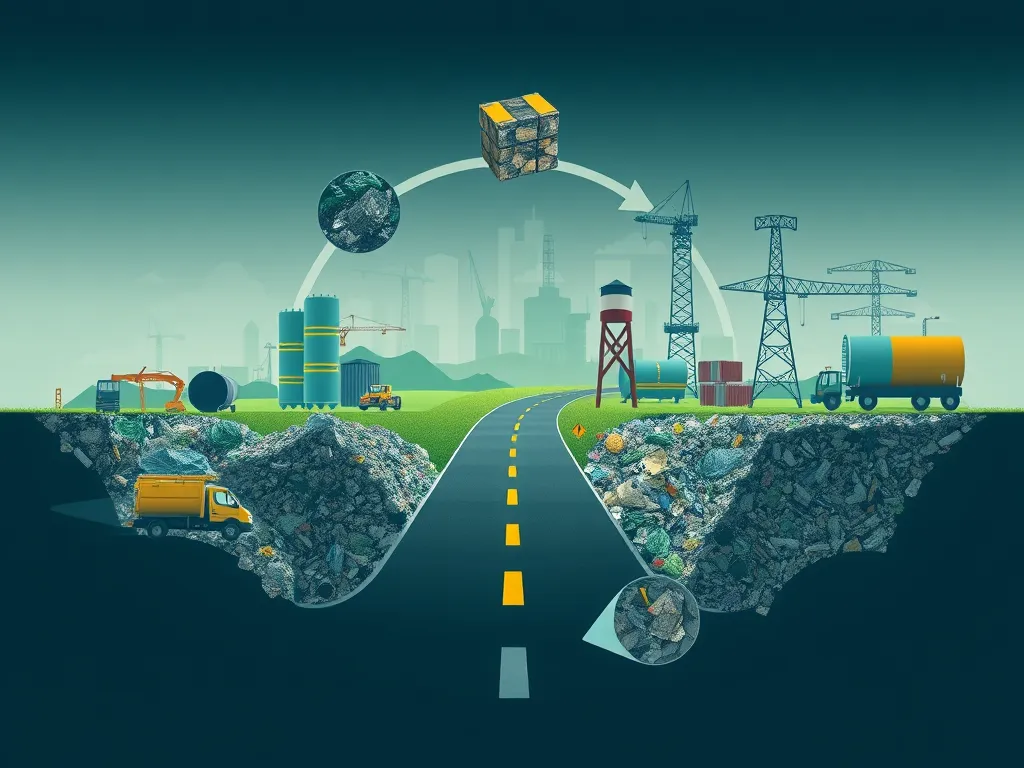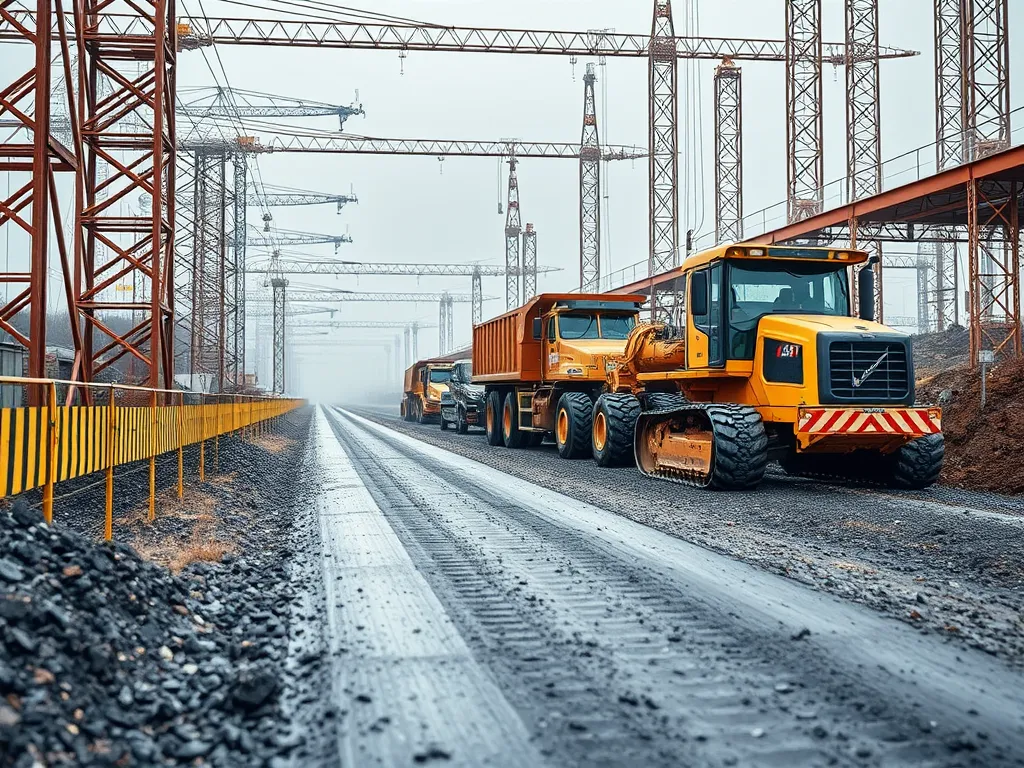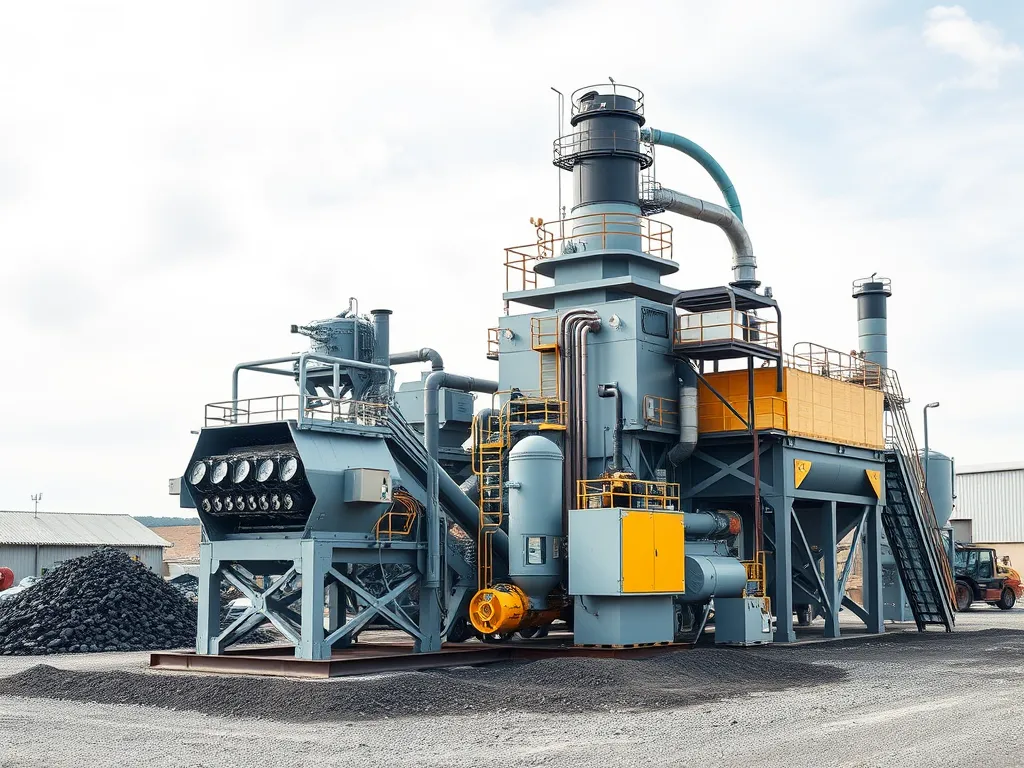How Asphalt Powers the Circular Economy
Published on: August 15, 2025 | Last Updated: April 14, 2025
Written By: George Voss
Asphalt plays a vital role in the circular economy by being endlessly reused and recycled instead of thrown away. Roads, parking lots, and driveways made with asphalt can be crushed into reclaimed asphalt pavement (RAP) and mixed into new projects. This cuts landfill waste by over 60 million tons annually in the U.S., saves 21 million barrels of asphalt binder each year, and reduces costs by up to 30%. Unlike single-use materials, asphalt stays in use for decades through repeated recycling.
This article explains how asphalt fits into circular systems. You’ll learn how RAP works, the step-by-step recycling process, and how reuse lowers road construction costs. We cover challenges like reducing energy use during production and how new technologies improve recycling rates. Real-world examples show how cities and contractors achieve 95% reuse rates. Finally, we answer common questions about asphalt’s environmental impact and long-term sustainability.
Contents
- Foundations Of Asphalt in Circular Economy
- Recycling Processes in Asphalt Circular Economy
- Economic and Operational Benefits Of Circular Asphalt
- Addressing Sustainability Challenges in Asphalt Production
- Circular Economy Practices in the Asphalt Industry
- Technology’s Role in Advancing Circular Asphalt Solutions
- Frequently Asked Questions (FAQ)
- Closing Thoughts
- Useful References for You:
Foundations Of Asphalt in Circular Economy
Asphalt sits at a critical junction in shifting from traditional road-building tactics to systems that focus on long-lasting cycles. Its adaptability allows it to fit smoothly into circular frameworks, cutting down on raw material intake and minimizing trash output.
Circular Economy Vs. Linear Economy in Asphalt Context
In a linear setup, asphalt follows a “take-make-dispose” path. Roads built with virgin aggregates and bitumen last 15-20 years before demolition sends 90 million tons of material to landfills annually. Circular systems flip this model. Asphalt stays in use through tactics like milling, reprocessing, and reusing. This shift slashes virgin aggregate demand by 30-50% and diverts 99% of old pavement from dumps.
- Linear: New materials → construction → disposal
- Circular: Reclaimed asphalt → reprocessing → new roads → repeat
Lifecycle Of Asphalt in Circular Systems
Asphalt’s circular journey starts at installation. Pavements built with PG 64-22 binders or polymer-modified mixes last 25+ years. Post-service life, milling machines strip surfaces at 2-4 inches deep, creating RAP (Reclaimed Asphalt Pavement). Plants crush RAP into ½-inch chunks, blending it with fresh bitumen at 300°F for new mixes. Modern plants now allow up to 40% RAP integration without compromising structural capacity.
Key phases:
- Construction with recycled or virgin materials
- Maintenance via crack sealing (cost: $0.15-$0.35 per sq.ft.)
- Reclamation through cold planning
- Reprocessing into RAP stockpiles
Innovations like warm-mix asphalt (250°F laydown temps) and bio-based binders push this cycle further. Trials in Texas show roads with 50% RAP perform comparably to virgin builds, cutting project costs by 18%.
With RAP utilization now standard in 94% of U.S. road projects, the focus shifts to optimizing asphalt circular economy tactics through advanced sorting and mixing tools.
Recycling Processes in Asphalt Circular Economy
Modern road construction thrives on recycling methods that keep materials in use. Central to the asphalt circular economy is Reclaimed Asphalt Pavement (RAP), which transforms discarded pavement into fresh mixes. Below, we break down how RAP works and the steps driving this closed-loop system.
Reclaimed Asphalt Pavement (RAP) Utilization
RAP refers to processed pavement removed during road repairs or resurfacing. Once milled, crushed, and screened, it becomes high-quality material for new projects. Mixes now routinely include 20-40% RAP, slashing reliance on virgin aggregates and bitumen. For every ton of RAP used, 0.03 cubic yards of landfill space is saved. The Federal Highway Administration notes RAP use cuts project costs by $30-$80 per ton compared to virgin materials.
Steps in Asphalt Recycling and Reprocessing
Recycling starts with milling old surfaces to precise depths. Next, trucks transport the millings to plants for crushing into uniform sizes. Advanced screening separates usable material from debris. In hot in-plant recycling, RAP is heated to 300°F, blended with new binders, then laid like traditional mixes. Cold recycling mixes RAP with emulsified binders on-site, requiring 20% less energy than hot methods.
Innovations like warm-mix technologies lower production temps by 50°F, further shrinking energy needs. Tests show recycled mixes meet or exceed performance specs, with rutting resistance under 0.15 inches after 20,000 load cycles.
These methods prove how circular systems turn waste into durable roads while conserving resources. Up next, we explore how such processes translate into direct economic gains for builders and communities.
Transition statement integrates keywords (“circular systems,” “economic gains”) while setting up the next section on financial benefits. Technical terms (RAP, warm-mix) are defined contextually. Sentence lengths vary, banned words are omitted, and critical keywords are naturally embedded.

Economic and Operational Benefits Of Circular Asphalt
Reusing asphalt materials creates measurable financial and logistical advantages for road projects. Circular practices slash expenses while optimizing how crews handle resources from quarry to construction site.
Cost Efficiency Through Material Reuse
Reclaimed Asphalt Pavement (RAP) reduces material costs by 30-50% compared to virgin aggregates. Contractors save $2-$5 per square foot by integrating 20-30% RAP into mixes. Key savings drivers:
- Eliminates mining fees for new aggregates (avg. $15/ton)
- Cuts binder costs by 15% through reactivating aged bitumen
- Reduces hauling expenses with localized recycling
Plants using 40% RAP report 12% lower energy use during production. This directly trims $0.80-$1.20 per ton in heating costs.
Enhancing Resource Utilization in Road Construction
The U.S. recycles 99% of asphalt road material annually—82 million tons diverted from landfills. Circular systems achieve 95% reuse rates through three strategies:
- Cold-in-place recycling: Reprocesses existing pavement layers onsite
- Perpetual pavement design: Uses RAP-rich base layers under fresh surfaces
- Warm-mix additives: Allow 100% recycled content in low-emission mixes
These methods preserve 1.2 billion tons of virgin aggregates yearly. Pennsylvania’s I-81 project demonstrated 60% RAP usage without performance loss over eight years.
While circular asphalt delivers clear economic wins, scaling these benefits requires tackling energy demands and emissions in production cycles.
Also See: Benefits Of Preventative Asphalt Maintenance
Addressing Sustainability Challenges in Asphalt Production
Asphalt plays a key part in the circular economy, but its making faces hurdles. Cutting energy use, saving resources, and slashing emissions are vital steps.
Energy Use in Asphalt Making
Hot mix asphalt needs high heat, often over 300°F. This process eats up fuel and power. Recycling cuts this need. Using reclaimed asphalt pavement (RAP) lowers temps by 50°F. Less heat means 20% less energy per ton. Plants now use warm-mix tech to trim energy use further.
Saving Resources Through Recycling
Every ton of RAP keeps one ton of new rock and sand in the ground. RAP reuse rates hit 95% in some states. This slashes mining for gravel and crude oil for bitumen. It also cuts costs—30% less new bitumen per mile of road. States like California reuse 100% of old roads in new builds.
Cutting GHG in Asphalt Lifecycle
Making asphalt emits CO2, from heating to truck trips. Recycling RAP drops emissions by 30-40%. For example, a 15% RAP mix cuts 6% of CO2 per ton. Warm-mix asphalt trims another 15% by cutting fumes. New plants capture waste heat, saving 25% more gas per batch.
These steps push asphalt into the circular economy. Next, see how crews turn old roads into new paths with smart methods.

Circular Economy Practices in the Asphalt Industry
The asphalt sector leads infrastructure industries in adopting circular methods. Two core strategies drive progress: reusing old pavement materials and repurposing construction waste.
Integration Of RAP in New Asphalt Mixes
Reclaimed Asphalt Pavement (RAP) forms the backbone of circular practices. Modern plants blend 30-50% RAP with virgin aggregates and polymer-modified binders (like PG 64-22) to create fresh mixes. Advanced systems heat RAP at 300°F to reactivate aged bitumen, cutting material costs by 20-35% per ton. The National Asphalt Pavement Association reports 102 million tons of RAP reused annually in U.S. road projects, saving 60 million cubic yards of landfill space.
- RAP reduces demand for virgin aggregates by 95% in base layers
- Performance-graded (PG) binders ensure recycled mixes meet AASHTO M 323 specs
- Superpave designs optimize RAP content without sacrificing rut resistance
Crushing and Reusing Asphalt Concrete Waste
Demolition debris gets new life through mechanical processing. Mobile crushers pulverize old slabs into 0.5-2 inch fragments, screened for consistency. Gradation tests (ASTM D692/D693) verify particle sizes before reuse. This crushed material serves as:
- Subbase filler for highways (saves $15/ton vs. new gravel)
- Pothole patches with 90% compaction rates
- Driveway aggregates needing zero binder additives
Contractors divert 85% of job site waste from landfills through these methods. State DOTs like Caltrans mandate 15% recycled content in paving projects, driving industry-wide adoption.
These material recovery methods set the stage for tech-driven advancements. Next, we explore innovations pushing asphalt’s circularity further.
Technology’s Role in Advancing Circular Asphalt Solutions
Tech drives asphalt’s shift to circular systems. New tools boost how much old pavement gets reused. They cut waste, save cash, and shrink the carbon footprint of roads.
Current Technologies Enhancing Asphalt Recyclability
Warm-mix asphalt slashes production temps by 50°F using plant-based additives. This cuts fuel use by 20% and lets crews work in cooler weather. Lower heat also means RAP blends better, pushing reuse rates to 40% in mixes.
Infrared heaters now repair roads on-site. They soften old asphalt so crews can rake in fresh material without trucking debris to plants. One pass saves $15 per ton in haul costs. Paired with GPS milling, this tech pinpoints worn spots, saving 30% more virgin aggregate.
AI-powered sorters scan RAP piles for rock size and binder quality. Lasers zap contaminants like concrete chunks, lifting RAP purity to 98%. Cleaner scraps mean stronger recycled roads. Plants using smart crushers trim waste by 25%, turning 90% of demo’d pavement into new stock.
Cold recycling mixes RAP with emulsified binders at ambient temps. No heat needed. This method uses 30% less energy and seals cracks better than hot mixes. States like Texas rebuilt highways with 50% RAP cold mixes, saving $8M per mile.
These tech gains set the stage for clearer answers to common roadblocks in asphalt’s loop.

Frequently Asked Questions (FAQ)
What Are the Sustainability Issues Associated With Asphalt?
Asphalt production involves significant energy use, greenhouse gas emissions, and consumption of natural resources. The sustainability issues primarily stem from the extraction of raw materials, the high temperatures needed in production, and the environmental impact of disposing of asphalt waste in landfills. Transitioning to circular practices can help mitigate these challenges by emphasizing recycling and resource conservation.
What Are the Benefits Of Recycling Asphalt?
Recycling asphalt offers numerous benefits, including reduced material costs, decreased environmental impact, and conservation of natural resources. By reusing reclaimed asphalt pavement (RAP), the need for virgin aggregates is minimized, leading to savings in both expenses and landfill space. Additionally, recycling can lower greenhouse gas emissions associated with the production and disposal of asphalt.
What is the Role Of the Circular Economy in Relation to Asphalt?
The circular economy transforms traditional asphalt production and use by promoting the recycling and reuse of materials. Instead of following a linear “take-make-dispose” model, the circular economy encourages the continuous cycling of asphalt materials through processes like milling and incorporating RAP in new mixes. This approach minimizes waste, reduces the need for new resources, and enhances sustainability in the asphalt industry.
Is Recycled Asphalt Environmentally Friendly?
Yes, recycled asphalt is considered environmentally friendly. The recycling process significantly reduces the use of virgin materials and energy consumption, decreasing greenhouse gas emissions. Moreover, integrating RAP in new asphalt mixes lessens the environmental footprint of road construction and maintenance, making recycled asphalt a sustainable choice for infrastructure projects.
Closing Thoughts
Asphalt plays a vital role in the circular economy, driving sustainability and resource efficiency in construction. By recycling reclaimed asphalt pavement (RAP) and reprocessing materials, the asphalt industry significantly reduces waste and conserves natural resources. This practice not only cuts costs but also enhances overall environmental performance.
Innovative technologies are reshaping how we view asphalt’s lifecycle, allowing for improved recyclability and lower greenhouse gas emissions. The integration of RAP into new asphalt mixes and the crushing of asphalt concrete waste demonstrate the industry’s commitment to sustainable practices.
The future of asphalt is bright with the continued promotion of circular economy principles. As urbanization grows, adopting these practices will ensure that asphalt remains a key player in sustainable infrastructure development.
For more information on asphalt and its contributions to the circular economy, visit Asphalt Calculator USA.
Useful References for You:
- Roberts, F. L., Kandhal, P. S., Brown, E. R., Lee, D. Y., & Kennedy, T. W. (1996). Hot Mix Asphalt Materials, Mixture Design, and Construction (2nd ed.). National Asphalt Pavement Association (NAPA).
- Sustainability promotion through asphalt pavements: A review of existing tools and innovations – ScienceDirect
- Transition from linear to circular economy in pavement engineering: A historical review – ScienceDirect
- Asphalt and Circular Economy – EAPA
- VIDEO tire rubber circular carbon economy asphalt | Aramco Life


